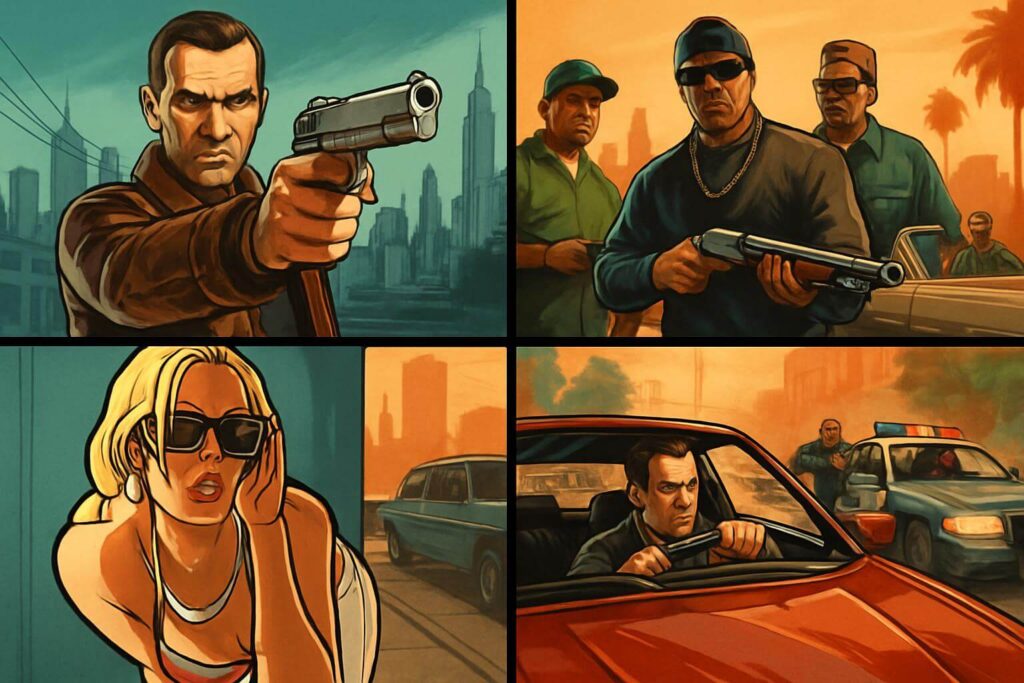
Some games entertain. Few redefine an industry. And then there is Grand Theft Auto. What started as a simple crime game in the late 1990s grew into a cultural force that shaped how the world sees video games. Its journey is not just about cars and chaos. It is about freedom, ambition, and the power of storytelling.
The Birth of a Crime Game
In 1997, a small Scottish studio created a game that looked simple but carried big ideas. Grand Theft Auto allowed players to steal cars, complete missions, and cause chaos in a city viewed from above. The graphics were plain. The controls were rough. Yet the concept was bold. Players had never seen this level of freedom. It caused controversy because of its violence. But the attention worked in its favor. The game gained a cult following. The sequel, GTA II, arrived in 1999. It added more detail but kept the same top-down style. Many thought the series would stay small. No one knew it was about to change the gaming world.
GTA III Sparks a Revolution
The real turning point came in 2001. GTA III entered the scene with a fully 3D open world. Suddenly, players were not just looking down at cars. They were inside a living city. They could walk the streets, listen to radio stations, and follow a cinematic storyline. Liberty City felt alive with pedestrians, traffic, and crime. The scale and detail were groundbreaking. Games had offered action before, but not this kind of freedom. Players could ignore missions and just explore. That freedom turned GTA into a mainstream sensation. It marked the true beginning of the phenomenon.
Vice City and San Andreas Expand the Dream
After the success of GTA III, the series did not slow down. Vice City arrived in 2002 with its neon lights and 1980s Miami atmosphere. The story mixed crime, style, and nostalgia. The soundtrack made players feel they were living in a different era. Two years later, San Andreas pushed boundaries even further. This time the map covered an entire state. Players could explore three big cities, countryside, and deserts. Customization entered the game. Characters could eat, exercise, or even change appearance. Gangs, street life, and social commentary made it a cultural landmark. GTA was no longer just a game. It became a mirror to society, wrapped in satire and freedom.
GTA IV Brings Realism and Depth
By 2008, technology had moved forward. GTA IV took the franchise into a new phase. It told the story of Niko Bellic, an immigrant chasing the American Dream in Liberty City. The tone was darker and more realistic. The physics engine made every movement feel natural. Cars handled with weight. Characters reacted to the world. The city looked gritty and alive. It was less playful than earlier titles, but it gave players a story with depth and emotion. This was GTA proving it could be more than entertainment. It could be a work of art in digital form.
GTA V and the Rise of the Phenomena
In 2013, GTA V arrived and broke every rule of scale. It introduced three main characters with their own stories. The map was massive, covering Los Santos and surrounding areas. Players could switch between protagonists and live different lives in the same world. The freedom was unmatched. Sales exploded. It became one of the best-selling games in history. Then came GTA Online. This multiplayer world turned GTA into a platform that never stopped growing. Updates kept it alive for over a decade. Players created roleplay servers, heists, and new stories. GTA was no longer just a video game. It became a phenomenon of global entertainment.
The Legacy of GTA’s Journey
From a simple top-down crime simulator to a billion-dollar cultural icon, the journey of GTA is unmatched. It challenged norms, courted controversy, and reshaped how games tell stories. Every chapter pushed limits in new ways. Today, millions wait for the next step, GTA VI. The hype alone proves the journey has not ended. It shows how a daring idea from the 1990s grew into one of the biggest forces in modern culture.
In the end, GTA is not just a franchise. It is proof that when freedom meets creativity, a game can become a phenomenon that defines generations.



